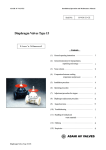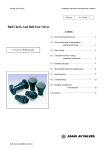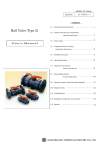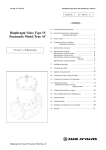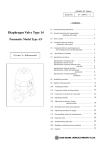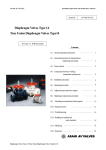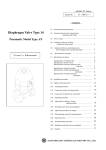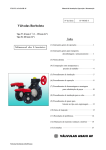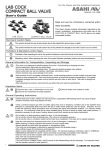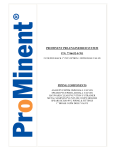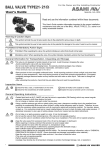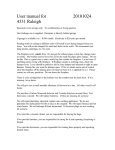Download 3-WAY TRUE UNION BALL VALVES
Transcript
ASAHI AV Valves
Serial No.
H – V003 E – 0
Contents
3-WAY TRUE UNION
BALL VALVES
User’s Manual
(1) General operating instructions
1
(2) General instructions for transportation,
unpacking and storage
1
(3) Name of parts
2
(4) Comparison between working
temperature and pressure
3
(5) Installation procedure
4
(6) Operation procedure
7
(7) Disassembling method for replacing parts
8
(8) Inspection items
9
(9) Troubleshooting
9
(10) Handling of residual and
waste materials
9
(11) Inquiries
10
ASAHI ORGANIC CHEMICALS INDUSTRY CO., LTD.
- 0 -
General operating instruction
○ Operate the valve within the range of the published working temperature and pressure.
(The valve can be damaged by operation beyond the maximum allowable range of temperature vs pressure.)
○ To select a valve in appropriate materials, refer to “CHEMICAL RESISTANCE ON ASAHI AV VALVE”.
(Some chemicals give heavy damage to valve materials.)
○ The valve is not designed to bear any kind of external load. Never stand on or place anything heavy on the valve
at anytime.
○ When the valve is disposed of, contact waste disposal specialist.
(The valve generates toxic gas.)
○ The valve should be installed at place where space for periodic inspection & maintenance is sufficient.
○ Do not store or install the valve near any heat source or hot surface.
○ Do not use the valve for fluid containing slurry. (The valve will not operate properly.)
○ Do not use the valve on condition that fluid has crystallized.
(The valve will not operate properly.)
○ Caution: Certain liquid such as H2O2, NaC1O, etc may be prone to vaporization which may cause irregular
pressure increases, which may destroy the valve.
(2) General instructions for transportation, unpacking and storage
○ Keep the valve in its original packaging until needed for installation.
○ Avoid contact with any coal tar creosote, insecticides, vermicides or paint.
(The force of swelling may damage the valve.)
○ The valve is not designed to handle any kind of impact. Avoid throwing or dropping the valve.
○ Avoid scratching the valve with any sharp object.
- 1 -
(3) Name of parts
Nominal size 15mm-100mm (1/2”-4”)
No.
1
◯
2
◯
3
◯
4b
◯
4c
◯
4d
◯
5
◯
6
◯
7
◯
8
◯
9
◯
10
◯
11
◯
12
◯
13
◯
14
◯
DESCRIPTION
Body
Ball
Carrier
End connector (Flanged end type)
End connector (Socket end type)
End connector (Threaded end type)
Union nut
Stem
Seat
O-ring (A)
O-ring (B)
Cushion
O-ring (D)
O-ring (E)
Stop ring
Handle
13 → Use only with Flanged type
◯
4d → Only with C-PVC 15-25mm(1/2”-1”)
◯
- 2 -
(4) Comparison between working temperature and pressure
Nominal size: 15mm-50mm (1/2”-2”)
Nominal size: 80mm, 100mm (3”, 4”)
Caution
Do not operate the valve beyond the range of working temperature and pressure.
(The valve can be damaged.)
- 3 -
(5) Installation procedure
Flanged Type
Necessary items
● Torque wrench
● Spanner wrench
● AV gasket
● Bolt, Nut, Washer (For many flanges specification)
(When a non-AV gasket is used, a different tightening torque specification should be followed.)
Procedure
1) Set the AV gasket between the flanges.
2) Insert washers and bolts from the pipe side, insert washers and nuts from the valve side, then
temporarily tighten them by hand.
Remark
The parallelism and axial misalignment of the flange surface should be below the values in the following. The
three ways are all as following.
(A failure to observe then can cause destruction due to stress application to the pipe)
Unit : mm (inch)
Nom. Size
15-25mm
(1/2”-1”)
40-80mm
(1 1/4”-3”)
100mm
(4”)
Axial
Misalignment
Parallelism
(a-b)
1.0 (0.04)
0.5 (0.02)
1.0 (0.04)
0.8 (0.03)
1.0 (0.04)
1.0 (0.04)
(Axial misalignment)
(Parallelism)
3) Using a torque wrench, tighten the bolts and nuts gradually to the specified torque in a diagonal manner.
(Refer to fig.1.)
Specified torque value 15mm
Nom. Size
(1/2”)
17.5
Torque value
{179}
[155]
20mm
(3/4”)
17.5
{179}
[177]
25mm
(1”)
20.0
{204}
[200]
40mm
(1 1/2”)
20.0
{204}
[200]
Unit: N-m {kgf-cm} [lb-inch]
50mm
80mm
100mm
(2”)
(3”)
(4”)
22.5
30.0
30.0
{230}
{306}
{306}
[200]
[266]
[266]
Fig. 1
Remark
Avoid excessive tightening. (The valve can be damaged.)
- 4 -
Threaded type
Necessary items
● Sealing tape(A non-sealing tape can cause leakage.)
● Strap wrench(Do not use Pipe wrench.)
● Spanner wrench
Remark
Make sure that the threaded connections are plastic x plastic.
(Metallic thread can damage the body cap)
Procedure
1) Wind a sealing tape around the external thread of joint, leaving the end (about 3mm) free.
5 with a strap wrench..
2) Loosen the union nut ◯
5 and the end connector ◯
4d .
3) Remove the union nut ◯
5 through the pipe.
4) Lead the union nut ◯
4d lightly by hand.
5) Tighten the external thread of the joint and the end connector ◯
6) Using a spanner wrench, screw in the end connector by turning 180°- 360°carefully without damaging it.
Remark
Avoid excessive tightening. (The valve can be damaged.)
8 is mounted.
7) Make sure that the O-ring (A) ◯
5 lightly by hand.
8) Tighten the union nut ◯
9) Using a strap wrench, screw it in by turning 90°- 180°carefully without damaging it.
Remark
Avoid excessive tightening. (The valve can be damaged.)
- 5 -
Socket type
Necessary items
● Adhesive for hard vinyl chloride pipes
● Strap wrench (Do not use the pipe wrench)
Remark
Do not install a socket type valve where the atmospheric temperature is 5℃ or lower.
(The valve can be damaged.)
Procedure
5 with a strap wrench.
1) Loosen the union nut ◯
5 and end connector ◯
4c .
2) Remove the union nut ◯
5 through the pipe.
3) Lead the union nut ◯
4c by wiping with waste cloth.
4) Clean the hub part of the end connector ◯
5) Apply adhesive evenly to the hub part of the end connector and the pipe spigot.
Remark
Do not apply more adhesive than necessary.
(The valve can be destroyed due to solvent cracking.)
Adhesive quantity (guideline)
Nom. Size
15mm
(1/2”)
20mm
(3/4”)
25mm
(1”)
40mm
(1 1/2”)
50mm
(2”)
65mm
(2 1/2”)
80mm
(3”)
100mm
(4”)
Quantity(g)
1.0
1.3
2.0
3.5
4.8
6.9
9.0
13.0
4c and leave it alone for at least 60
6) After applying adhesive, insert the pipe quickly to the end connector ◯
seconds.
7) Wipe away overflowing adhesive.
8 is mounted
8) Make sure that O-ring(A) ◯
5 lightly by hand.
9) Tighten the union nut ◯
10) Using a strap wrench, screw it in by turning 90°- 180°carefully without damaging it.
Remark
Avoid excessive tightening. (The valve can be damaged.)
- 6 -
(6) Operating Procedure
○ Turn the handle gently to open or close. The handle can be turned 360°.
(Turn the handle clockwise to close and counter clockwise to open.)
○ The arrow on top of the handle indicates the flow direction.
Open to the left
The handle is parallel to the
pipe.
The direction of the arrow is
left.
Fully closed
Open to the right
The handle is parallel to the
The handle is perpendicular to the pipe.
pipe.
The direction of the arrow is
right.
○ With AV 3-WAY TRUE UNION BALL VALVES, the direction of flow, left and right, is shown above.
- 7 -
(7)Disassembling Method for Replacing Parts
Necessary items
● Strap wrench
● Protective gloves
● Wrench or vice
● Safety goggles
● Screwdriver (+)
Caution
Wear protective gloves and safety goggles as some fluid remains in the valve.
(You may be injured.)
<Disassembly>
Procedure
1) Completely discharge fluid from pipes.
2) Turn the handle to full close.
5 on both sides with a strap wrench.
3) Loosen the union nuts ◯
(With 3-WAY TRUE UNION BALL VALVES, loosen the three union nuts.)
4) Disconnect three joints and remove the body part only. As for the flanged type, remove the bolt.
(With 3-WAY TRUE UNION BALL VALVES, the body part can be pulled up just with loosening
5 .)
the union nut ◯
14 off the body part.
5) Loosen the screw of the handle with a screwdriver (+), and pull the handle ◯
3 .
6) Using a wrench or vice, engage the carrier ◯
3 counter clockwise to loosen.
7) Turn the carrier ◯
8) Follow 6) and 7) for the other side.
3 in the same way.)
(With 3-WAY TRUE UNION BALL VALVES, loosen the carrier ◯
2 by hand.
9) Push out the ball ◯
6 from the top flange side to the body side.
10) Push out the stem ◯
<Assembly>
Procedure
Carry out the assembly work in the reverse procedure.
- 8 -
(8) Inspection items
○ Inspect the following items;
(1)
(2)
(3)
(4)
Check for any flaw, crack, or deformation on the outside.
Check whether fluid leaks to the outside.
Check whether tightness of bolt nut.
Check whether the handle operates smoothly.
(9) Troubleshooting and action
Problem
Cause
The carrier is loosened .
Fluid leaks from the valve The seat is scratched or worn.
even when the valve is closed
fully.
Foreign matter is in the valve.
Fluid leaks from the valve.
The handle is not (can not be)
turned smoothly.
The handle fails to engage.
Action
Adjust the face pressure between the
ball and the seat.
(Refer to page 8)
Replace the seat with a new one.
Clean the valve.
The ball is scratched or worn.
Replace the scratched ball with a new
one.
The O-ring is scratched or worn.
Replace the O-ring with a new one.
Foreign matter is in the valve.
Clean the valve.
Deformation. (By heat etc.)
Replace the parts.
The stem is broken.
Replace the stem with a new one.
The engagement between the stem and the ball Replace the stem and ball with new
is broken.
ones.
(10) Handling of residual and waste materials
Remark
In discarding remaining or waste materials, be sure to ask waste service company.
(Poisonous gas is generated.)
- 9 -
(11) Inquiries
Head Office
: No. 2-5955, Nakanose- Cho, Nobeoka – City, Miyazaki- Pref. , Japan.
Tel (81) 982-35-0880 Fax (81) 982-35-9350
Tokyo Office
: (Furukawachiyoda Bldg.) No. 15-9, Uchikanda 2- Chome, Chiyoda-Ku, Tokyo, Japan.
Tel (81) 3-3254-8177 Fax (81) 3-3254-3474
Singapore Branch Office: 16 Raffles Quay, #40-03 Hong Leong Building, Singapore 048581.
Tel (65) 220-4022 Fax (65) 324-6151
Europe Representative Office:Am Wehrhahn 33, 40211, Duesseldorf, Germany.
Tel (49) 6172-9175-0 Fax (49) 6172-9175-25
ASAHI AMERICA Inc.: 35 Green Street Malden, Massachusetts U.S.A. 02148
Tel (1) 781-321-5409 Fax (1) 781-321-4421
- 10 -
3-WAY TRUE UNION BALL VALVE
ASAHI ORGANIC CHEMICALS INDUSTRY CO., LTD.
Information in this manual is subject to change without notice.
- 11 -
2000. 11














